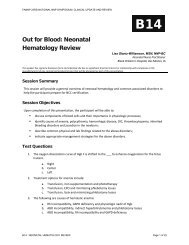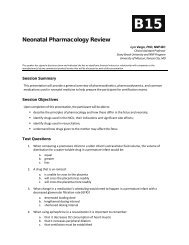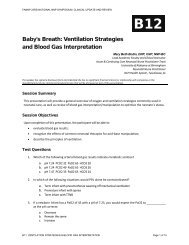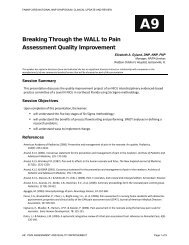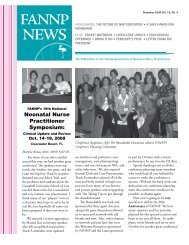Differential Diagnosis and Management of Respiratory ... - FANNP
Differential Diagnosis and Management of Respiratory ... - FANNP
Differential Diagnosis and Management of Respiratory ... - FANNP
You also want an ePaper? Increase the reach of your titles
YUMPU automatically turns print PDFs into web optimized ePapers that Google loves.
<strong>FANNP</strong> 23RD NATIONAL NNP SYMPOSIUM: CLINICAL UPDATE AND REVIEW<br />
BPD vs. CLD<br />
Definitions<br />
•Late <strong>Respiratory</strong> Distress in the neonate.<br />
• “Many experts now believe the term,<br />
Bronchopulmonary Dysplasia (BPD), is more accurate<br />
in describing the pathogenesis <strong>and</strong> that Chronic Lung<br />
Disease (CLD) is not a specific diagnosis or<br />
description.” (Dr. Namasivayam Ambalavanan, UAB<br />
Division <strong>of</strong> Neonatology).<br />
•Use <strong>of</strong> supplemental oxygen for greater than 28 days<br />
after birth.<br />
•Use <strong>of</strong> supplemental oxygen at 36 weeks post<br />
conceptional age (predictor <strong>of</strong> more severe pulmonary<br />
dysfunction in early childhood).<br />
•Classic BPD follows a course <strong>of</strong> primary pulmonary<br />
failure.<br />
•The “New BPD” is described in<br />
ELBW infants who may have had minimal or no lung<br />
disease (?interference with sepatation).<br />
Risk Factors<br />
DDx for similar x-ray changes<br />
•Same risk factors as for<br />
RDS<br />
•Chorioamnionitis<br />
•Tracheal colonization with<br />
ureaplasma<br />
•Extremely low birth<br />
weight<br />
•Symptomatic PDA<br />
•Sepsis<br />
•Oxygen therapy<br />
•Vitamin A deficiency<br />
•Family history <strong>of</strong> atopic<br />
disease<br />
• Str<strong>and</strong>ing with lymphatic engorgement or<br />
atelectasis.<br />
• Cardiomegaly if large PDA or fluid overload.<br />
• Chronic changes are early <strong>and</strong> severe if from<br />
infection. (R/O myco/ureaplasma pneumonia)<br />
Laboratory Findings<br />
<strong>Management</strong><br />
•ABG: CO2 retention. If chronic, pH is usually >7.25.<br />
•Electrolytes: Elevated serum bicarbonate from<br />
chronic CO2 retention; hyponatremia, hypokalemia or<br />
hypochloremia if chronic diuretics; elevated BUN or<br />
creatinine if fluid restricted.<br />
•Urinalysis: RBCs from possible nephrocalcinosis from<br />
prolonged diuretics.<br />
•Prevent prematurity!<br />
•Reduce exposure to risk factors: minimize oxygen<br />
toxicity, minimize excessive tidal volume, judicious<br />
fluid administration, timely PDA closure, adequate<br />
nutrition.<br />
•CPAP shortly after birth with avoidance <strong>of</strong><br />
intubation <strong>and</strong> mechanical ventilation.<br />
•Vitamin A prophylaxis?<br />
B07: MANAGEMENT OF RESPIRATORY DISTRESS Page 13 <strong>of</strong> 23



